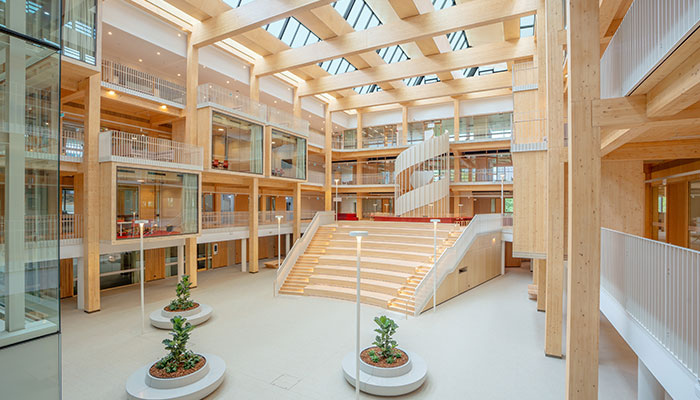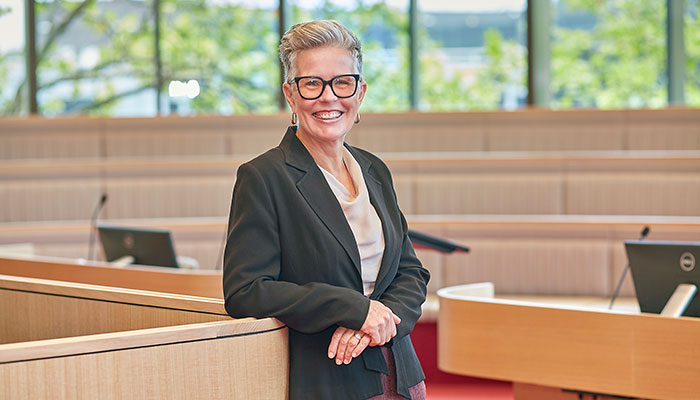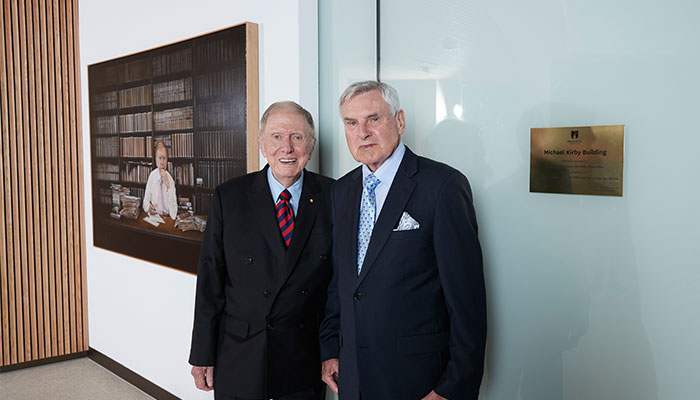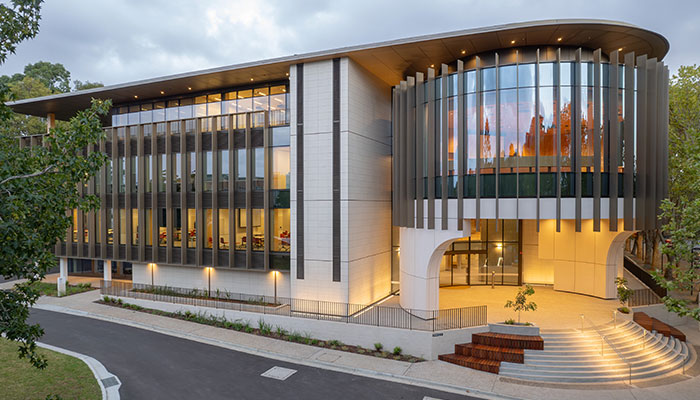The new home of the Macquarie Law School and the Department of Philosophy in the heart of campus has officially opened this month, with the new landmark reflecting the progressive and inclusive values of the university through innovative architectural design.

Collaboration atrium: Located at the University’s Wallumattagal Campus at North Ryde, the building (pictured above) is the new home for staff, students and partners of Macquarie Law School, as well as the Department of Philosophy, within the Faculty of Arts.
The building is named after The Honourable Dr Michael Kirby AC CMG, the pioneering human rights lawyer, High Court Justice and international jurist, who was also the first justice to come out as a gay man. One of the lecture theatres is named after Johan van Vloten, Kirby’s husband and partner of more than 50 years.
“Naming it after them celebrates their contributions to society and the diversity of our university,” says Professor Lise Barry, Dean of the Macquarie Law School. “It’s a great recognition of their partnership and what they achieved and we’re very proud of that.”
Kirby worked on numerous bodies for the United Nations, the World Health Organisation, the Commonwealth Secretariat and the Organisation for Economic Co-operation and Development (OECD). He was also Australia’s longest serving judge, including Justice of the High Court of Australia from 1996 until 2009, having served as Chancellor of Macquarie University between 1984 and 1993.

Connections and collaborations: Dean of Macquarie Law School Professor Lise Barry, (pictured above), says the new building facilitates broad community opportunities across the faculties as well as providing innovative teaching spaces.
Those already using the building are more than impressed. Third-year law and commerce student Connor Chandler, 20, says the architectural brilliance and “sheer wow factor” took his breath away when he first stepped into the building.
The moot court, designed to reflect the features of an actual working courtroom, is one of his favourite parts of the building, says Connor.
“It looks incredible because it’s round and floating, it’s cantilevered out over the front entrance, so state-of-the-art, almost revolutionary,” he says.
“There are places for the plaintiff and defendant and the bench as well, where you and your team can mimic what you’d be doing if you became a barrister,” he says. Student groups will also be able to practice there for national and international mooting competitions.
Professor Albert Atkin, Deputy Dean, Education and Employability in the Faculty of Arts said the open-plan design of the building will encourage transformative education and world-leading interdisciplinary research within the Faculty of Arts and across Macquarie University.
“Collaboration and innovation are central to the design of the Michael Kirby Building,” Professor Albert Atkin says.
“The Michael Kirby Building is a space to inspire, energise and excite us about the future of the arts, humanities and social sciences."
Shedding light on equality, environmental law and education
The 8,600 square metre Michael Kirby Building was built on the foundations of the original law building at 17 Wally’s Walk. Hassell architects retained some of the 1980s off-form concrete structure in their design.
The four-storey building is based around a full-height atrium, reputed to be one of the largest in a timber building in Australia, and is covered in a steel saw tooth roof with integrated photovoltaic panels.
We want to give you a great experience physically as well as mentally. We want to contribute to your wellbeing by learning in a beautiful environment.
This contributes to its five-star rating from the Green Building Council of Australia, along with the architect's extensive use of cross-laminated timber, which reduces its carbon footprint while creating a warm and tactile environment.
“There's an amazing sense of light and being connected to nature,” says Professor Barry. “That’s really fitting, since we've got the oldest centre for environmental law in Australia. It creates this sense of calm and peace.”
The ground floor contains teaching spaces and large lecture theatres, while levels one and two have the Law Commons and academic offices, as well as specialist law teaching and learning facilities. The top level provides a terrace and event and meeting spaces. The teaching spaces and tutorial rooms are all technologically equipped with screens and facilities to enhance learning.
Chandler also is enthusiastic about the Law Commons which features private workspaces, but also large tables. It’s a dedicated study area for students to work collaboratively and individually.

Partners in life and work: The Honourable Dr Michael Kirby AC CMG (pictured left) told opening night guests that like the building itself, he and his partner of more than 50 years, Johan van Vloten (pictured right), symbolise equality and dignity for all.
“This is where students can study together and provide support to each other,” says Professor Barry. “In ten years time, these might be some of the most important connections you have, when your colleagues are in positions of influence.” The building also has a book-lined quiet law reading room.
Previously, the faculty offices were across disparate buildings. Professor Barry says this new design will allow teachers and students to mingle and collaborate more easily.
“It creates such an amazing sense of community between staff and students and the broader university,” Professor Barry says. “It’s the interdisciplinary interconnectedness of the law school with other faculties and other disciplines, which is fantastic, how law informs science, philosophy, psychology or medicine.”
Embedded in the building is Wallumatta Legal, a low fee, not-for-profit law firm set up to assist family law clients who don’t qualify for legal aid, but can’t afford a private lawyer. It was created by international law firm DLA Piper and Macquarie University. Students can also do internships there.
The new building will offer much more space for the student-run Law Society (MULS) to hold events, such as the annual clerkship fair and also provides office space, storage and meeting rooms for MULS.

Design meets opportunity: The moot court, which extends over the building’s façade (pictured above) and over the University’s main throughfare, promotes professional competency and helps prepare the next generation of legal leaders.
“This building signifies the university's investment in the law school and the importance that the university places on law,” says Professor Barry. “It signifies to prospective students that we value you. We want to give you a great experience physically as well as mentally. We want to contribute to your wellbeing by learning in a beautiful environment.”
The building reflects the future-focussed nature of the faculty. “It’s thrilling to think that some of the next generation of legal minds will be forged here in this building,” Chandler says.
With a proud history of innovation and strong values, Macquarie Law School educates future leaders who aspire to make tomorrow better.
The Macquarie University Faculty of Arts is home to a passionate community of scholars committed to serving students and engaging the community through transformative education and world-leading research. Our interdisciplinary teaching and research seeks to stimulate positive change and address local, national and global challenges.



